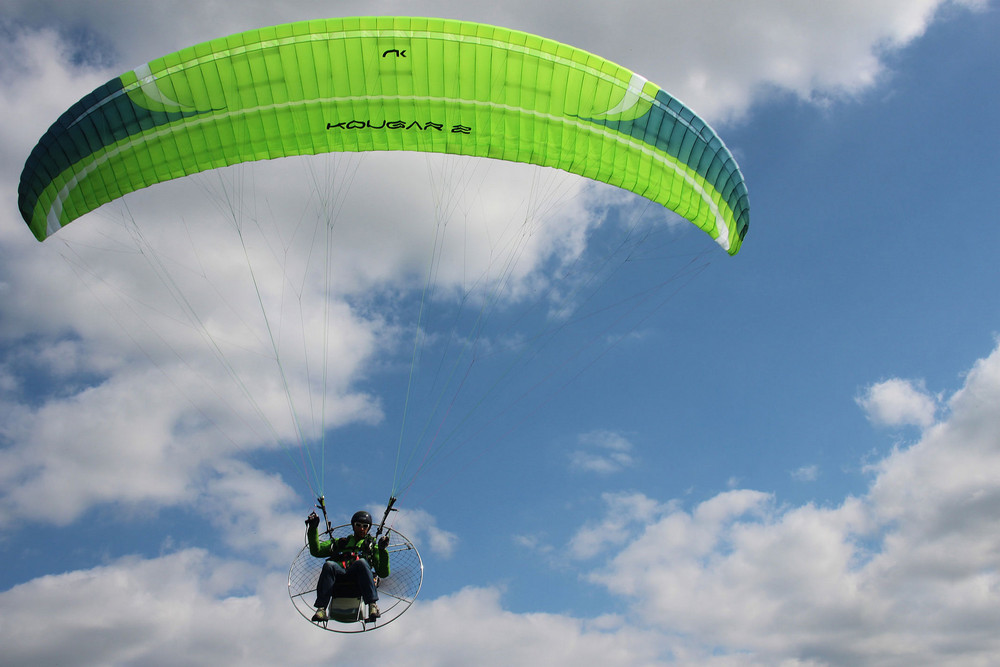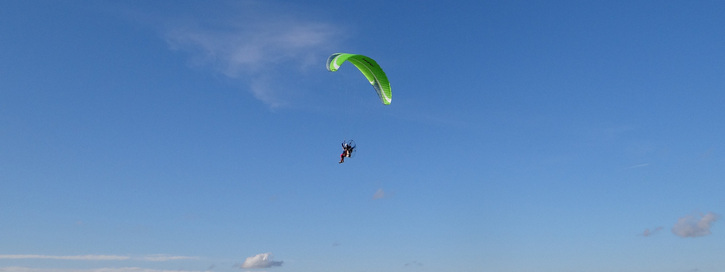
I had the opportunity to test fly Niviuk's Kougar 2, a new reflex powered paragliding (PPG) wing aimed at experienced paramotor pilots who, to quote Niviuk, are: "... looking for fast, powerful and reliable wings enabling them to reach their goals". Here are my first impressions...
Having had such an excellent paragliding cross country flying season in the UK this year, it'd been quite a while since I last flew a paramotor. So I was really hoping for a nice steady breeze for my first launch. But it was not to be!
Instead I was taunted by light and variable winds at ground level: light westerly for a few seconds; then light southerly; then nothing; then light north-westerly; etc. Darn. This wasn't going to be as easy as I'd hoped! But a good test of the wing in light wind conditions, I told myself.
New wing. New paramotor engine. New site. Tricky launch conditions. Lack of currency. Not ideal!
I was testing the size 23 Kougar 2 with an all-up of around 105 kg, giving a wing loading of around 4.57 kg per m2. So, from my experience of other reflex PPG wings, I was expecting to have to pull the risers relatively long and hard to get the wing up and flying, and then run long and hard to get off the ground.
However I was very pleasantly surprised to find that the Kougar 2 inflated and rose up to flying position easily, with no tendency to hang back, and I was off the ground in just a few steps. Certainly the best reflex PPG wing I've flown to date in terms of launch characteristics!
I was then immediately struck by the Kougar 2's excellent climb rate, glide performance and speed; it certainly feels very efficient all-round. I also think it's a very nice looking wing, with a very clean sail and a stylish design.

Having become airborne and settled into the harness, you need to adjust the trim for climbing under power. I find the trimmer system on the Kougar 2 nicely constructed and relatively easy to use. I like that it's a closed-loop of webbing so you don't have a long bit of webbing flapping around, or any hook and loop fastener patches which usually need re-securing as with some other PPG wings. The ratchets are very good quality.
Having gained confidence in the wing, it was time to play! I had fun with some foot-dragging, low-level slalom, mild wingovers, turn reversals and tight 360s - just to see how it handled, you understand.
The Kougar 2's brakes are relatively short and its handling is precise, responsive and agile, especially when using the tip-steering lines. These are particularly useful when flying accelerated, and can be used with or without the brakes (by clipping the brakes on to their magnets and reaching up to hold the tip-steering lines directly). You can definitely turn the Kougar 2 tightly if you want to, especially by using the brakes and tip-steering lines in combination, but you have to be careful when you do this as you can lose height quickly in a steeply banked turn. This is to be expected given the high wing loading and should come as no surprise to the kind of experienced pilot this wing is aimed at.

Trims fully off (full reflex) felt quick and the wing felt nice and solid, despite bouncing around through a marked low-level inversion with moderate wind shear (cold air above with the next weather front approaching).
The speed system felt good too, with a relatively long travel. I felt the wing did become noticeably more lively when fully accelerated with the speed system but nothing untoward happened. Using the speed system and trimmers in combination, it felt solid and very fast!
 Niviuk say the safety of the Kougar 2 is around EN C, which seems about right to me, although like most PPG wings it's not freeflight certified.
Niviuk say the safety of the Kougar 2 is around EN C, which seems about right to me, although like most PPG wings it's not freeflight certified.
I did a number of touch-and-gos, experimenting with the brakes and trims, and it was precise and controllable - great for landing gently exactly where you want to.
Despite having good wing loading and speed, I needed less power to climb and maintain than I have done with other PPG wings so my fuel consumption was significantly less.
Although I didn't get to try it myself, Niviuk say that the Kougar 2 is also excellent for freeflight i.e. it can be flown without an engine. From how it felt I can certainly believe it, and think that it should make an excellent dual-purpose paramotoring and freeflight wing, although it is clearly a wing made for powered flying first and foremost.
One small criticism: Niviuk supply the Kougar with a 175 L rucksack. PPG pilots don't usually put their harness in the rucksack; it stays attached to the engine! Most PPG pilots I know use a fast pack bag, some use a concertina bag (which I think they should, as it's good for the longevity of the wing). I'd suggest either remove the rucksack from the package (and reduce the retail price accordingly) or - even better - include a purpose built PPG fast pack bag. Pilots can always buy a separate rucksack as an optional extra if they want one.
To sum up, the Kougar 2 is a superb PPG wing with easy inflation, excellent performance (climb rate, glide, speed) and agile handling, which I can very happily recommend to experienced paramotor pilots. Its responsive handling and relatively short brake travel don't suit new, low-airtime or heavy-handed pilots, who are better suited to Niviuk's Link, their entry-level PPG wing.
More info: Niviuk Kougar 2

